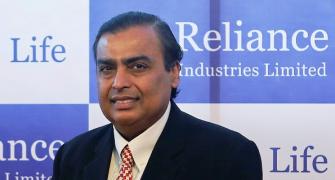Raising concerns about freedom of the press in India, Rahul Khullar, chairman of TRAI believes, big corporates and heavyweight politicians who own media firms are calling the shots in newsrooms. This not only restricts powers of an editor but also leaves enough room for ‘distortion’ of news.
Telecom Regulatory Authority of India (Trai) Chairman Rahul Khullar’s (bottom, left) decision to cap broadcasters’ advertising time at 12 minutes an hour did not go down well with many news channels, which went to court, claiming this would make them financially unviable.
 Now, even as controversies over ‘paid news’ and political and corporate honchos putting their money in media houses sparks a debate on the role of media, Khullar talks about the challenges the industry faces in its pursuit of freedom. In an interview with Surajeet Das Gupta & Sounak Mitra, he also talks about the base price for 800-MHz spectrum and challenges posed by free chat services. Excerpts:
Now, even as controversies over ‘paid news’ and political and corporate honchos putting their money in media houses sparks a debate on the role of media, Khullar talks about the challenges the industry faces in its pursuit of freedom. In an interview with Surajeet Das Gupta & Sounak Mitra, he also talks about the base price for 800-MHz spectrum and challenges posed by free chat services. Excerpts:
A lot of big corporate houses and politicians are getting into media. This has raised concerns about the freedom of press. Trai has been working on the issue of media companies’ ownership and cross-holdings. What is your view on the issue?
Trai is working on this and will come out with recommendations. There are many troublesome issues and each needs to be deliberated upon to ensure the media’s freedom of speech.
There are three main kinds of owners — politicians, corporate houses, and non-media corporate establishments.
We have to deal with the ownership issues surrounding each. There are some critical areas that need to be looked into. At media firms owned by corporate houses, where is the line dividing boardrooms and newsrooms?
There also is the question of editors’ independence from boards. That is, are bottom lines driving bylines?
The directors of a company owning a media firm should not dictate journalists what they should write. If a media company owned by a corporate house expresses views in a certain way (which it is free to do), there should be appropriate disclaimers, such as a clear identification of ownership.
Politicians owning media houses book advertisements and publish their own propaganda.
What made you decide to keep the base price of 800-MHz spectrum higher than that of 1,800-MHz, despite the industry’s demand for the opposite?
We were not out to deliberately raise the price of 800-MHz spectrum. We don’t increase or reduce the valuation of spectrum by a priori intent. Valuation is always based on some scientific methods that are open to public scrutiny.
Trai decides on the valuation and then arrives at a reserve price, based on available information. It has always been our position that valuation is not infallible. That is why we give a cushion when setting reserve prices.
 In the recent auction of 900-MHz spectrum, it was seen that the industry had valued spectrum well above Trai’s valuation and reserve price. But, in 1,800-MHz spectrum, most of the airwaves were sold at base price in more than half the service areas where reserve price was below valuation. This vindicates Trai’s position on prices.
In the recent auction of 900-MHz spectrum, it was seen that the industry had valued spectrum well above Trai’s valuation and reserve price. But, in 1,800-MHz spectrum, most of the airwaves were sold at base price in more than half the service areas where reserve price was below valuation. This vindicates Trai’s position on prices.
The method we followed to determine the valuation and reserve price of 900-MHz and 1,800-MHz spectrum led to a successful auction. When the regulator began working on 800-MHz valuation, it proposed many methods that were similar to those used earlier.
The industry criticised all methods, as they had done in the case of 900-MHz and 1,800-MHz spectrum, but failed to give any alternative.
How did Trai arrive at the method that determined the valuation and price of 800-MHz spectrum?
When Trai recommended valuation and price for 1,800-MHz and 900-MHz bands, there was no market-discovered rate. But, before the 800-MHz spectrum pricing, we already had seen a successful auction of 1,800-MHz spectrum.
This market information on price discovery had to be taken into account while in determining the valuation and price of 800-MHz airwaves. It is a known fact that 800-MHz spectrum is nearly twice more efficient than 1,800-MHz.
That is a law of physics; not a point of view. Considering this, 800-MHz had to be valued higher than 1,800-MHz. The range could be anywhere between one and two times the value of 1,800-MHz spectrum.
One of the main issues needed to be addressed was making sure that the contiguous five MHz of spectrum was made available to the operators. This needed reassignment of frequencies in the 800-MHz band.
Some operators already had contiguous five MHz, while others did not. If the allocation is not contiguous, spectral efficiency suffers. Contiguous spectrum yields 40 per cent or more efficiently there.
Also, some amount of spectrum is lost in guard bands. We considered all possible options and showed that contiguous spectrum could be made available to operators through reassignment, with minimal disruption. So it can be done.
Why are CDMA operators unhappy?
At least one operator has publicly said it wants 800-MHz spectrum so that it can offer LTE (long-term evolution) services; that is their growth plan. This is not something we are saying. The heart of the matter is that some operators want to buy 800-MHz spectrum cheap, giving the excuse that CDMA is a dying technology.
But their aim is to use this spectrum for LTE services (on other new frequencies). This is clearly unfair; you can’t eat and not pay for it. Based on scientific methods, we arrived at a valuation for 800-MHz that was 1.45 times that of 1,800-MHz. We then set a reserve price by multiplying the valuation by 0.8. This is exactly what was done for 900-MHz and 1,800-MHz airwaves.
There are a few more issues that Trai has looked at. Considering the efficiency and global usage, 800-MHz can be used for LTE, and nobody stops existing GSM players from buying 800-MHz spectrum through auction. They could then use it for LTE with 1,800-MHz.
In your recommendations, you spoke about harmonisation and giving contiguous spectrum to operators in the next auction. But you also said the government should take back 800-MHz spectrum from BSNL and MTNL. How do you justify that?
BSNL and MTNL together cater to only about two per cent of all CDMA users. With so many operators in Delhi and Mumbai, porting will not be an issue. So, we suggested that the government take spectrum back from MTNL and sell it in the auction:
We will get much better value for it this way. BSNL, on the other hand, needs only one carrier of 1.25 MHz spectrum for rural exchanges. Earlier, the government has unilaterally done re-assignment in the 1,800-MHz band; in its recommendations, Trai has shown how it can be done with the least dislocation.
With instant chat application providers like WhatsApp and Viber getting traction in India and some (like BlackBerry Messenger) already offering voice services over the instant messaging platform, how do you see the need for regulating these companies?
How can we regulate them? They are OTT (over-the-top) and internet-driven. In India, the price for voice is much higher than the price for data (when measured in terms of data used). These applications, which can be downloaded on smartphones or tablets by anyone, are cost-effective and convenient to consumers.
Most importantly, users can message as well as talk for virtually no charge. Considering India’s low broadband and smartphone penetration, its impact has been limited on the country’s telcos. Once broadband is scaled up, telcos will surely face a serious impact.
At the moment, regulating these application services companies is not realistic — even China has not done it. And, even if you try to restrict a foreign app, do you seriously think that an Indian will not come up with an alternative?
What is your view on auction of 700-MHz spectrum? Has the government sought your suggestions on pricing for this band?
The next round of auctions will start within a few months. That will offer 800-MHz, 900-MHz, 1,800-MHz, and 2,100-MHz spectrum.
Once these auctions are over, operators will not have major issues with the a mount of spectrum available. The government has yet to decide on what technology should be adopted for 700-MHz airwaves.
The ecosystem will not develop unless that is decided. For instance, the US uses 700-MHz for LTE. Other countries are using other bands for LTE. India needs to decide what to do with 700-MHz spectrum. An auction is unlikely










